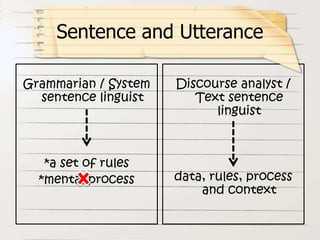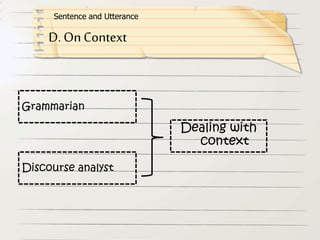Discourse analysis (Linguistics Forms and Functions)
- 2. DiscourseAnalysis Introduction:Linguistic Formsand Functions GdAfternn by: Group 1 (6C) Septiarani Pramasari and Satya Permadi English Education Department ©2012
- 3. Introduction: Linguistic Form and Function The Function of Language The Transactional View The Interactional View Spoken and Written Language Manner of Production The Representation of Discourse: Texts Written Text Spoken Text The Relationship Between Speech and Writing Differences in Form between Written and Spoken Language Sentence and Utterance On ‘Data’ Rules Versus Regularities Product Versus process On ‘context’ Mind Map
- 4. The Function of Language Discourse analysis is an umbrella term for all those studies within applied linguistics which focus on units/stretches of language beyond the sentence level DISCOURSEANALYSIS Human Life Natural Language Utterance Expression of content (Transactional) expressing social relations and personal attitudes (Interactional)
- 5. Transactionalview The Function of Language reflects the idea that the most important function of language is the expression of content aim to communicate information dominates the use of language a policeman gives directions to a traveller a doctor tells a nurse how to administer medicine to a patient “ ”
- 6. Interactionalview involved in expressing social relations and personal attitudes emotive and affective uses of language in daily discourse and is claimed to be in spoken form in general two strangers are standing at a bus-stop in an icy wind and one turns to the other and says “My goodness, it's cold”, the primary intention of the speaker are to convey information or it may indicating friendly and to talk “ ” The Function of Language
- 7. Spoken and Written Language Mannerof production production spoken and written languages Speaker Full range of voice quality effect Paralinguistic cues reinforce the meaning monitor what it is that he just said Observe interlocutor (A person who takes part in a conversation) gestures and facial expressions in order to support their message Writer write down the utterance choose his particular word Reorder what has just written change the unacceptable word
- 8. Criteria of Spokenand Written Text Spoken and Written Text Cohesion Coherence Intentionality Acceptability Informativeness Situationality Intertextuality grammatical relationship between parts of a sentence essential for its interpretation the order of statements relates one another by sense the message has to be conveyed deliberately and consciously satisfactory in that the audience approves it some new information has to be included in the discourse circumstances in which the remark is made are important reference to the world outside the text or the interpreters' schemata
- 9. Representation of a text Written Text Spoken and Written Text speeches characters/sentences paragraphs chapters effort of interpretation to assign a value to some of the less legible words Printed version Handwritten version once-for-all interpretation of a text which may never be read again readers can infer the message that the author intended to convey important sense of interpretation
- 10. SpokenText Tape-recording of a communicative act Text coughing, chairs creaking, buses going past, the scratch of a match lighting a cigarette Part of the text Analysis Spoken Language Transcribed and written on a paper Discourse analysts Orthographic conventions paralinguistic (spelling system of a language) Spoken and Written Text
- 11. Not expected to write down the details the speaker repeats sometimes several times over The Relationship between written and spoken language Written Language Spoken Language transference of information detailed transmission of factual information “ ”If cannot remember all the things in spoken mode Need to write it down to remember all the time Spoken and Written Text
- 12. Differences in Form between Written and Spoken Language Spoken and Written Text
- 13. Differences in Form between Written and Spoken Language Spoken and Written Text The syntax of spoken language is typically much less structured than written language Good “ ”
- 14. In written language we use “logical connector” such as: besides, moreover, however etc. In spoken language we use silence, or and, but, then, if Differences in Form between Written and Spoken Language Spoken and Written Text I’m so tired (because) I had to walk all the way home. “ ”
- 15. In written language, sentences are generally structured in subject- predicate form, but in spoken language we usually find like: “the cats + did you let them out ?” Differences in Form between Written and Spoken Language Spoken and Written Text
- 16. In chat about the immediate environment, the speaker may rely on gaze direction to supply referent, example: (looking at the rain) frightful isn’t it. Differences in Form between Written and Spoken Language Spoken and Written Text
- 17. In spoken language, speaker may replace or refine expressions as he goes along, example: this man + this cap she was going out with Differences in Form between Written and Spoken Language Spoken and Written Text
- 18. In spoken language, the speaker typically uses a good deal of rather generalized vocabulary, such as: things like that, a lot of, got, do, thing, and stuff. Differences in Form between Written and Spoken Language Spoken and Written Text
- 19. In spoken language, the speaker frequently repeats the same syntactic form several times, example: I look at fire extinguisher + I look at fire exits + I look at what gangways are available + I look at electric cables what + are they properly earthed + are they properly covered Differences in Form between Written and Spoken Language Spoken and Written Text
- 20. In spoken language, the speaker may produce a large number of prefabricated fillers, such as: well, erm, I think, you know, if you see what I mean, of course, and so on. Differences in Form between Written and Spoken Language Spoken and Written Text
- 21. Sentence and utterance Lyon (1977) ‘the product of ordinary language behavior’ Sentence and Utterance
- 22. System-sentences never occur as the products of ordinary language-behavior. Representations of system-sentences may of course be used in metalinguistic discussion of the structure and functions of language: and it is such representations that are customarily cited in grammatical descriptions of particular languages. (Lyon, 1977: 31) Sentence and Utterance
- 24. produce accurate descriptions of the particular language studied System sentence linguist Text sentence linguist Sentence and Utterance
- 25. Grammarian / System sentence linguist *a set of rules *mental process Discourse analyst / Text sentence linguist data, rules, process and context Sentence and Utterance
- 26. Grammarian * constructed the sentence or sentences he uses as examples Discourse Analyst * based on the linguistic output of someone other than the analyst A. On Data Sentence and Utterance
- 27. Grammarian *The rules are 100% fixed and true Discourse Analyst *Regularities *Discover regularities in his data and to describe them B. Rules versus Regularities Sentence and Utterance
- 28. Grammarian *his data is not connected to behavior *'the well-formed sentences of a language' Discourse Analyst *Connected to behavior *results of psycholinguistic processing experiments C. Product versus Process Sentence and Utterance
- 29. D. OnContext Sentence and Utterance Dealing with context Grammarian Discourse analyst
- 30. Discourse analysis is an umbrella term for all those studies within applied linguistics which focus on units/stretches of language beyond the sentence level (Judit, 2012). We as the human is use a natural language utterance which language serves in the expression of 'content' described as transactional and that function involved in expressing social relations and personal attitudes we describe as interactional. Spoken and written language has relation each other. But written language and spoken language have different form. The book concerns with sentence which is 'text-sentence‘, so it will connected to behavior and involves contextual considerations. The data which is used in this book is based on the linguistic output of someone other than the analyst. Besides, discourse analyst discovers regularities in his data. Conclusion
- 31. Discussions
- 32. Thank Yu !

































